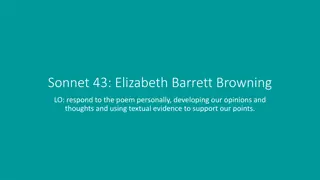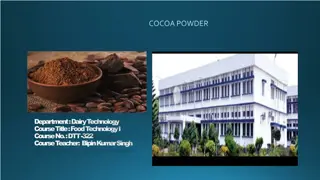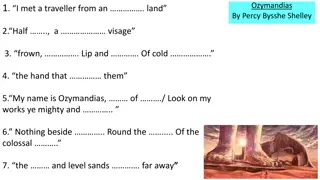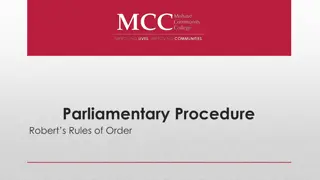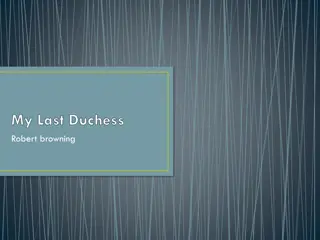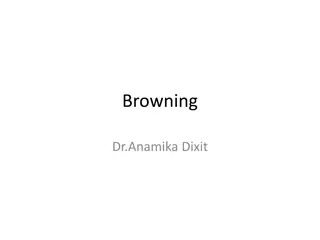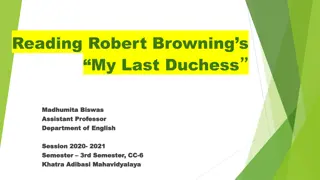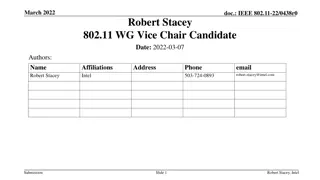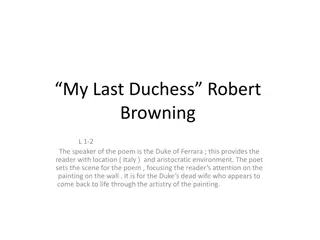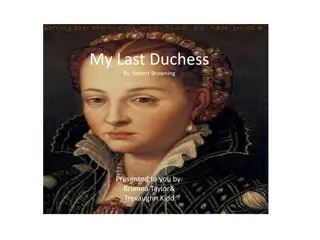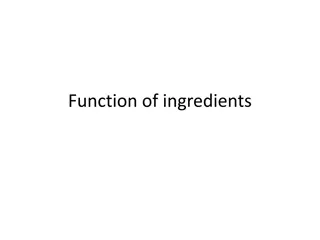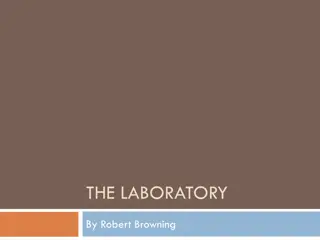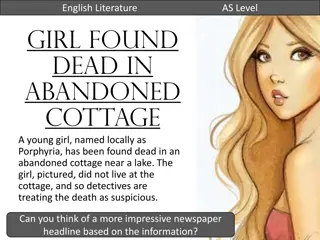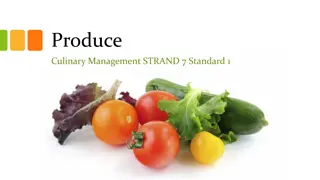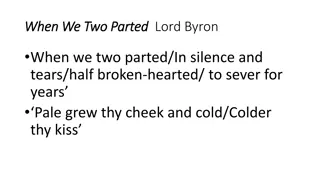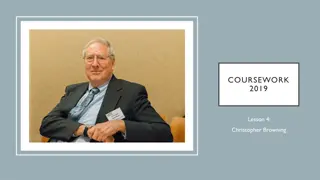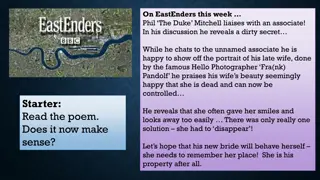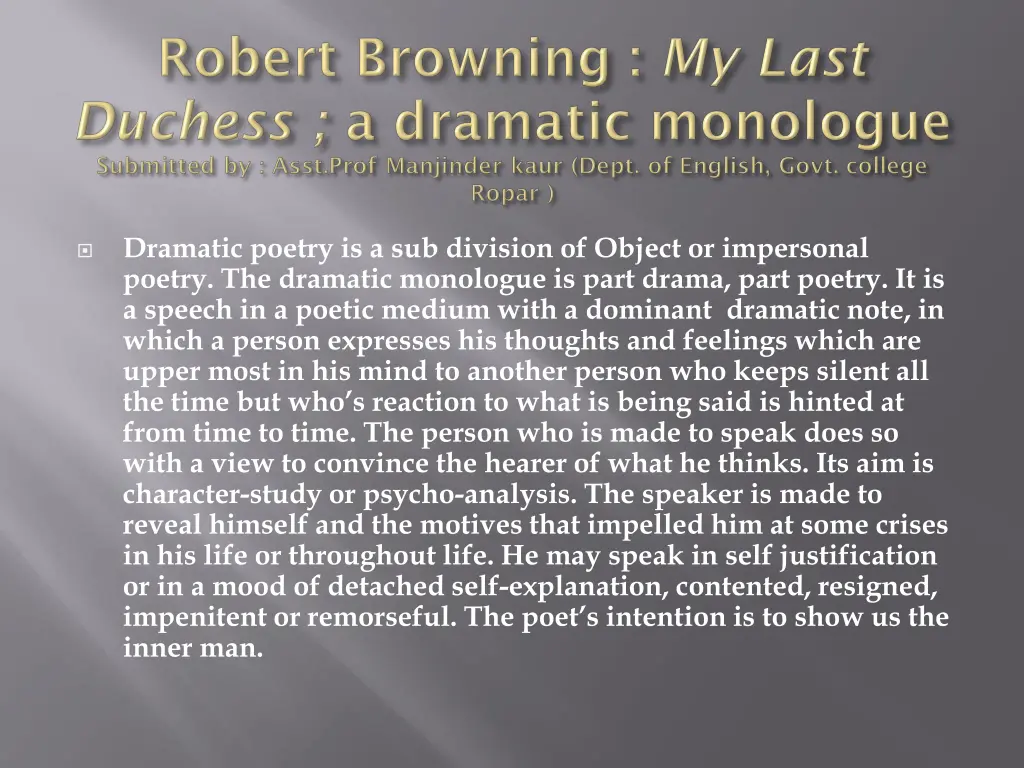
Understanding Dramatic Monologue in Poetry
Explore the essence of dramatic monologue in poetry, focusing on Browning's "My Last Duchess" as a prime example. Dive into the intricate layers of characterization, control, and irony portrayed through the speaker, unveiling a compelling narrative that engages readers on various levels.
Download Presentation

Please find below an Image/Link to download the presentation.
The content on the website is provided AS IS for your information and personal use only. It may not be sold, licensed, or shared on other websites without obtaining consent from the author. If you encounter any issues during the download, it is possible that the publisher has removed the file from their server.
You are allowed to download the files provided on this website for personal or commercial use, subject to the condition that they are used lawfully. All files are the property of their respective owners.
The content on the website is provided AS IS for your information and personal use only. It may not be sold, licensed, or shared on other websites without obtaining consent from the author.
E N D
Presentation Transcript
Dramatic poetry is a sub division of Object or impersonal poetry. The dramatic monologue is part drama, part poetry. It is a speech in a poetic medium with a dominant dramatic note, in which a person expresses his thoughts and feelings which are upper most in his mind to another person who keeps silent all the time but who s reaction to what is being said is hinted at from time to time. The person who is made to speak does so with a view to convince the hearer of what he thinks. Its aim is character-study or psycho-analysis. The speaker is made to reveal himself and the motives that impelled him at some crises in his life or throughout life. He may speak in self justification or in a mood of detached self-explanation, contented, resigned, impenitent or remorseful. The poet s intention is to show us the inner man.
In theory dramatic poetry must be objective but in the Dramatic Monologue there is self-portrayal ; and in practice it is used by the poet as a medium of self expression and presentation of his own philosophy. Browning who may be called the chief exponent of the Dramatic Monologue uses this form . Browning s MY LAST DUCHESS is an ideal example of purely objective Dramatic Monologue.
"My Last Duchess," published in 1842, is arguably Browning's most famous dramatic monologue, with good reason. It engages the reader on a number of levels historical, psychological, Ironic, theatrical, and more. The most engaging element of the poem is probably the speaker himself, the duke. Objectively, it's easy to identify him as a monster, since he had his wife murdered for what comes across as fairly innocuous crimes. And yet he is impressively charming, both in his use of language and his affable address. The ironic disconnect that colors most of Browning's monologues is particularly strong here. A remarkably amoral man nevertheless has a lovely sense of beauty and of how to engage his listener.
In fact, the duke's excessive demand for control ultimately comes across as his most defining characteristic. The obvious manifestation of this is the murder of his wife. Her crime is barely presented as sexual; even though he does admit that other men could draw her "blush," he also mentions several natural phenomena that inspired her favor. And yet he was driven to murder by her refusal to save her happy glances solely for him. This demand for control is also reflected in his relationship with the envoy. The entire poem has a precisely controlled theatrical flair, from the unveiling of the curtain that is implied to precede the opening, to the way he slowly reveals the details of his tale, to his assuming of the envoy's interest in the tale ("strangers like you .would ask me, if they durst, How such a glance came there"), to his final shift in subject back to the issue of the impending marriage. He pretends to denigrate his speaking ability "even had you skill in speech (which I have not), later revealing that he believes the opposite to be true, even at one point explicitly acknowledging how controlled his story is when he admits he "said 'Fra Pandolf' by design" to peak the envoy's interest. The envoy is his audience much as we are Browning's, and the duke exerts a similar control over his story that Browning uses in crafting the ironic disconnect.
To some extent, the duke's amorality can be understood in terms of aristocracy. attempted to explore the ironies of aristocratic honor. In this poem, loosely inspired by real events set in Renaissance Italy, the duke reveals himself not only as a model of culture but also as a monster of morality. His inability to see his moral ugliness could be attributed to having been ruined by worship of a "nine-hundred-years- old name. He is so entitled that when his wife upset him by too loosely bestowing her favor to others, he refused to speak to her about it. Such a move is out of the question "who'd stoop to blame this kind of trifling?" He will not "stoop" to such ordinary domestic tasks as compromise or discussion. Instead, when she transgresses his sense of entitlement, he gives commands and she is dead.
Another element of the aristocratic life that Browning approaches in the poem is that of repetition. The duke's life seems to be made of repeated gestures. The most obvious is his marriage the use of the word "last" in the title implies that there are several others, perhaps with curtain- covered paintings along the same hallway where this one stands. In the same way that the age of his name gives it credence, so does he seem fit with a life of repeated gestures, one of which he is ready to make again with the count's daughter. And indeed, the question of money is revealed at the end in a way that colors the entire poem. The duke almost employs his own sense of irony when he brings up a "dowry" to the envoy. This final stanza suggests that his story of murder is meant to give proactive warning to the woman he is soon to marry, but to give it through a backdoor channel, through the envoy who would pass it along to the count who might then pass it to the girl. After all, the duke has no interest in talking to her himself, as we have learned! His irony goes even further when he reminds the envoy that he truly wants only the woman herself, even as he is clearly stressing the importance of a large dowry tinged with a threat of his vindictive side.
Also at play psychologically is the human ability to rationalize our hang-ups. The duke seems controlled by certain forces: his own aristocratic bearing; his relationship to women; and lastly, this particular duchess who confounded him. One can argue that the duke, who was in love with his "last duchess, is himself controlled by his social expectations, and that his inability to bear perceived insult to his aristocratic name makes him a victim of the same social forces that he represents. Likewise, what he expects of his wives, particularly of this woman whose portrait continues to provide him with fodder for performance, suggests a deeper psychology than one meant solely for criticism. Finally, one can also understand this poem as a commentary on art. The duke remains enamored with the woman he has had killed, though his affection now rests on a representation of her. In other words, he has chosen to love the ideal image of her rather than the reality.
Thus My Last Duchess reveals the true Character of Duke himself and his last duchess through his own Monologue. The poem has been Browning s Master piece.

